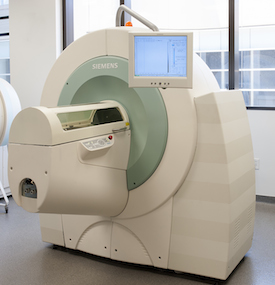Siemens Inveon PET/CT

Positron emission tomography (PET) is a nuclear medical imaging technique that produces a three-dimensional image of functional processes in the body. The system detects pairs of gamma rays emitted indirectly by a positron-emitting radionuclide (tracer), which is introduced into the body on a biologically active molecule.
In preclinical studies, PET imaging can be used for noninvasive detection and investigation of diseases in small animal models. Because of its absolute imaging quantification capabilities and superior sensitivity, PET has been the driving force of molecular imaging in the understanding of disease mechanisms. PET imaging has become a standard tool for diagnosis, treatment planning, and therapeutic efficacy monitoring in cancer patients.
The Small Animal Imaging core facility has a state-of-the-art Siemens Inveon PET/CT Multimodality System for laboratory animal PET and CT studies on a single integrated gantry. The multimodality system fully integrates each modality into a common data acquisition system for automatic transition between modes and seamless coordination of CT and PET data acquisition.
| PET | |
|---|---|
| Detector Type | LSO with 1.6x1.6mm detector pixel spacing |
| Detector Architecture | High efficiency light guide, 20x20 crystal array |
| Attenuation Correction | CT based |
| Field of View (FOV) | 12.7cm |
| Spatial Resolution | 1.4mm |
| Sensitivity | >10% |
| Reconstructions | 2D FBP, 3DRP, OSEM2D, OSEM3D/MAP |
| Suitability | Ideal for small molecules and small-molecule drug candidates, certain brain studies |
| CT | |
| X-ray Source | Variable-focus source |
| Focal Spot | Less than 6 microns |
| Maximum Resolution | 20 microns |
| 125mm Detector | 165mm (4064x4064 pixels) |
| Capabilities | Respiratory and Cardiac Gating |

